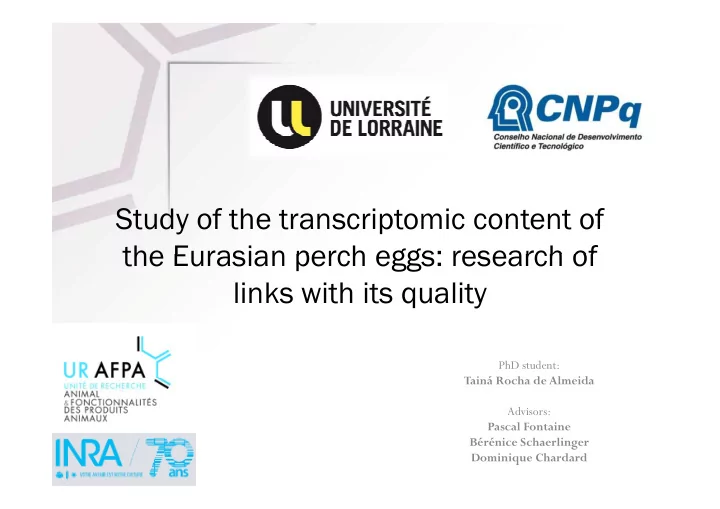

Study of the transcriptomic content of the Eurasian perch eggs: research of the Eurasian perch eggs: research of links with its quality PhD student: Tainá Rocha de Almeida Advisors: Pascal Fontaine Bérénice Schaerlinger Dominique Chardard
Reproductive cycle Growth Breeders PHOTOPERIOD PHOTOPERIOD AND AND TEMPERATURE TEMPERATURE Larvae Gametes Embryo 2 Photos: Yannick Ladore
Modulating factors Intrinsic Extrinsic • Breeder size • Environment • Rank of spawn • Stress • Genetics • Nutrition • Level of domestication • Level of domestication Survival Malformation rate 3
Early development failure • Major problem in fish breeding programs • Example Striped Bass: >50% until 4h = high quality >50% until 4h = high quality <30% until 4h = low quality (Chapman et al., 2014) 4
Fertilization and egg content M. Alix et al., 2015 SPERMATOZOA - Genetic material - Centrioli OOCYTE - Genetic material -Transcripts - Proteins (enzymes) - Lipids - Organelles - Metabolites 5
Oogenesis in the literature - Primary oocyte growth - Cortical granule formation - Vitellogenesis - Primary oocyte growth - Other events (nuage, vitelline envelope formation, intercellular - Cortical alveolus stage junctions, pigment formation, - Lipids inclusion intramitochondrial crystals, -Vitellogenesis annulate lamellae) - Maturation (Wallace and Selman, 1990) - Ovulation (T (T yler and Sumper, 1996) yler and Sumper, 1996) -Growth Previtellogenic - Oogonia formation Vitellogenic (regulation, yolk - Oogonia proliferation and protein formation, lipid transition into meiosis deposition, vitteline envelope - Secondary growth formation) - Maturation (competence, MIH -Vitellogenesis (lipid production, resumption of acumulation, vitellogenins, meiosis, cytoplasmatic uptake of vitamins, egg envelop maturation) proteins) - Ovulation - Maturation and hydration (Patino and Sullivan, 2002) - Ovulation (Lubzens et al., 2010) 6
Oogenesis • Growth – 1 st Previtellogenic growth (mRNA, CHO, proteins) – 2 nd – Vitellogenesis (lipids, vitamins) • Maturation – Meiosis resumption – Cytoplasmic maturation (synthesis of proteins from vitellogenin) • Ovulation • Ovulation – Metaphase II oocyte released from its follicule Image: Lubzens et al., 2010 7 Image: Lubzens et al., 2010
What is egg quality? Egg quality can be defined as the egg´s potential to produce a Good egg quality are usually defined as viable fry (Kjørsvik, those which exhibit low levels of 1990). mortality at fertilization, eying, hatch and first-feeding and those which and first-feeding and those which produce the fastest-growing and the healthiest fry and old fish (Bromage et al., 1992). Egg quality or oocyte developmental competence can be defined as the ability of the egg to be fertilized and subsequently develop into a normal embryo (Bobe & Labbé, 2010). 8
Assessing egg quality Firt feeding 15 dpf (Alix et al., 2015 ) Pattern of cleavage Malformations Survival until some stages Embryo Larvae Ovulation development development (Photos: D. Ż arski) (Photos: D. Ż arski) Maturation Fertilization Hatching process Rate Rate 6-14.5 dpf (Alix et al., 2015) 9
Indicators of egg quality Morphological Size (Kjorsvik and Lonning, 1983; Kjørsvik et al., 1990; Brooks et al.,1997; Bobe & Labbé, 2010) Oil droplets ( Ż arski et al., 2011) Cortical reaction ( Ż arski et al., 2012) 2012) Blastomere morphology (Bromage et al., 1994; Shields et al., Marine fish: 1997; Vallin et al., 1998; Kjorsvik et al., 2003) sink X float Specie specific Freshwater fish: Practices can interfere translucid X Bad quality white or opaque 10
Indicators of egg quality Biochemical Proteins (Nguyen et al., 2012) Proteomic (Castests et al., 2012) Lipids (Henrotte et al., 2010; Luo et al., 2015) Hormones (Skaalsvik et al., 2015) RNA (Aegerter et al., 2005) Ovarian fluid analysis: pH (Fauvel et al., 1993); proteins (Rime et al.,2004); osmolality , conductivity (Skaalsvik et al., 2015); enzymes (Lahnsteiner et al., 1999; Lahnsteiner et al., 2001) 11
Early development Maternal-to-zygotic transition (MZT) / • Midblastula transition (MBT) – Maternal transcript destabilization – Zygotic genome activation Image: Kimmel et al., 1995 Image: Kimmel et al., 1995 Cellular metabolism Basic cellular Nuclear and cellular divisions functions Intercellular adhesion (Chapman et al., 2014; Tadros & Lipshitz, 2009; Pelegri, 2003) 12
First goal of the project Defining the molecular portrait of a developmentally competent egg Zebra fish; Rainbow trout, Eurasian perch, and European seabass Head of the project: Julien Bobe 13
First goal of the project Image: Caroline Cheung 14
Steps of the analysis Genes Primers Training Primers •Tilapia •Genes of interest •RNA extraction optimiza- qPCR •Perch •Reference genes •RT •PCR tion •qPCR • 16 genes from • 13 Genes zebrafish homologous in • 13 perch perch we know homologous • 5 of reference 15
Samples available 2015 _______________ • 1 wild 2014 ________________ − 25 spawns • 2 wild • 1 domesticated • 1 domesticated 2013 2013 − 14 spawns − 14 spawns _______________ − 23 spawns • 1 mixed • 3 wild − 7 wild – 28 spawns − 23 domesticated • 1 domesticated – 8 spawns M. Alix et al., 2015 16
Categories ◊ I - No fertilization ◊ II - Fertilization rate lower than 30% ◊ III - Early mortality (more than 50% between 24 and 48 ◊ III - Early mortality (more than 50% between 24 and 48 hours post fertilization - hpf) ◊ IV - Low hatching rate (0-30%) ◊ V - Medium hatching rate (30-60%) ◊ VI - High hatching rate (higher than 60%) M. Alix, in process 17
Second goal of the project – Microarray analyze • New categorization – Maximize the differences – Easier to associate with the phenotype – Reliable results 18
Microarray analyze Image: Ball and Bazma, 2006 19
• Genes from Maternal Legacy Project Are the molecular mechanisms conserved? Samples available • Genes from microarray analysis There are new genes that are specific for egg There are new genes that are specific for egg Samples Samples quality on perch? available • Modulating factors affecting the gene expression Perspectives 20
Thank you for your attention Thank you for your attention Questions? Suggestions? (taina.almeida@univ-lorraine.fr/tainarochaalmeida@gmail.com) 21
Recommend
More recommend